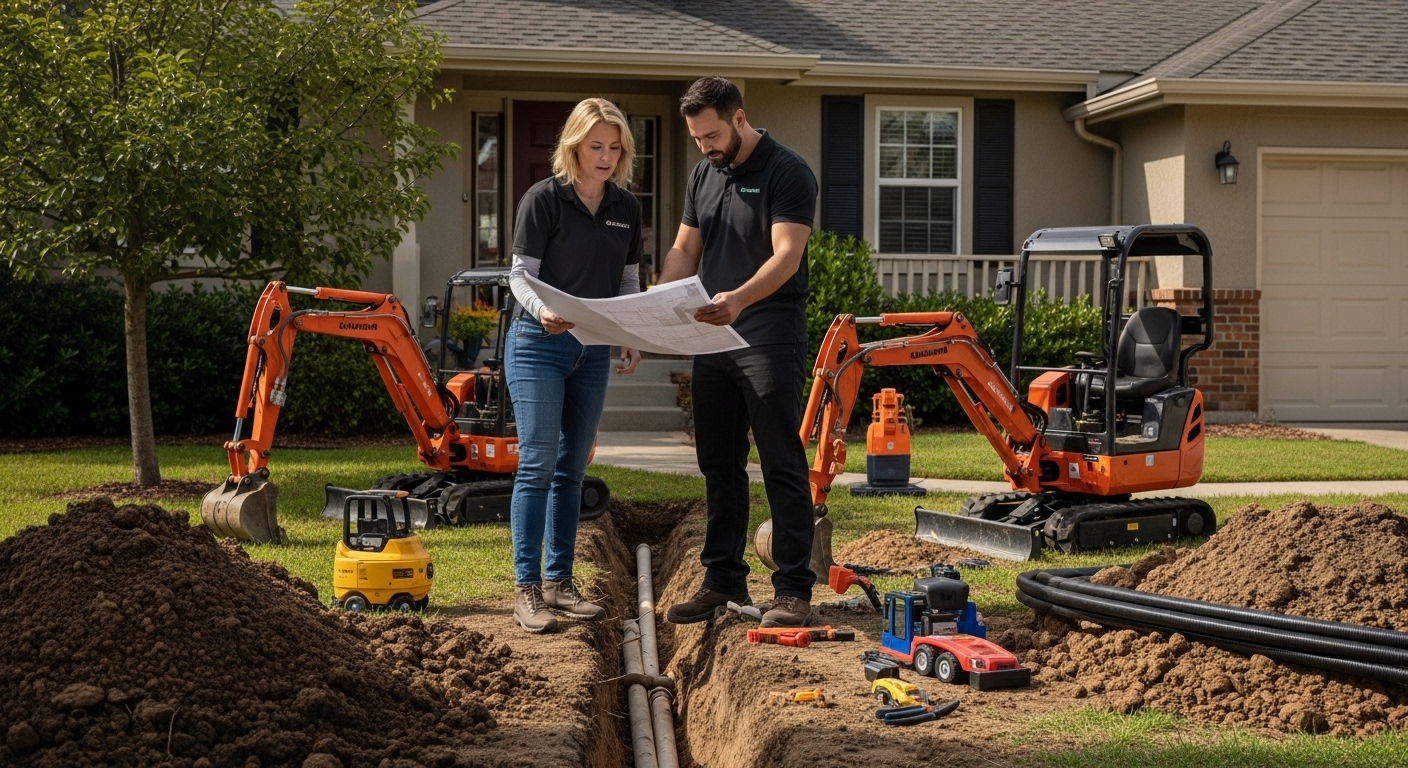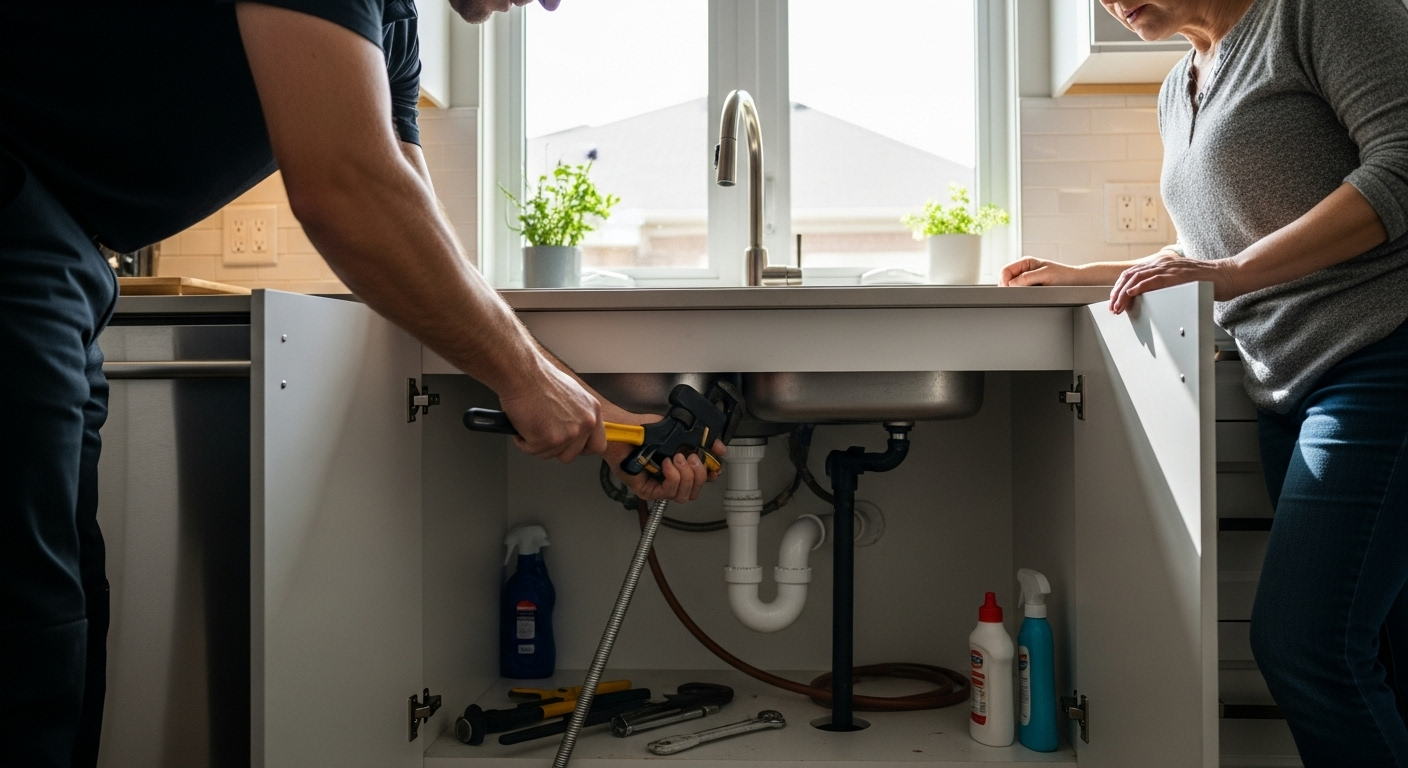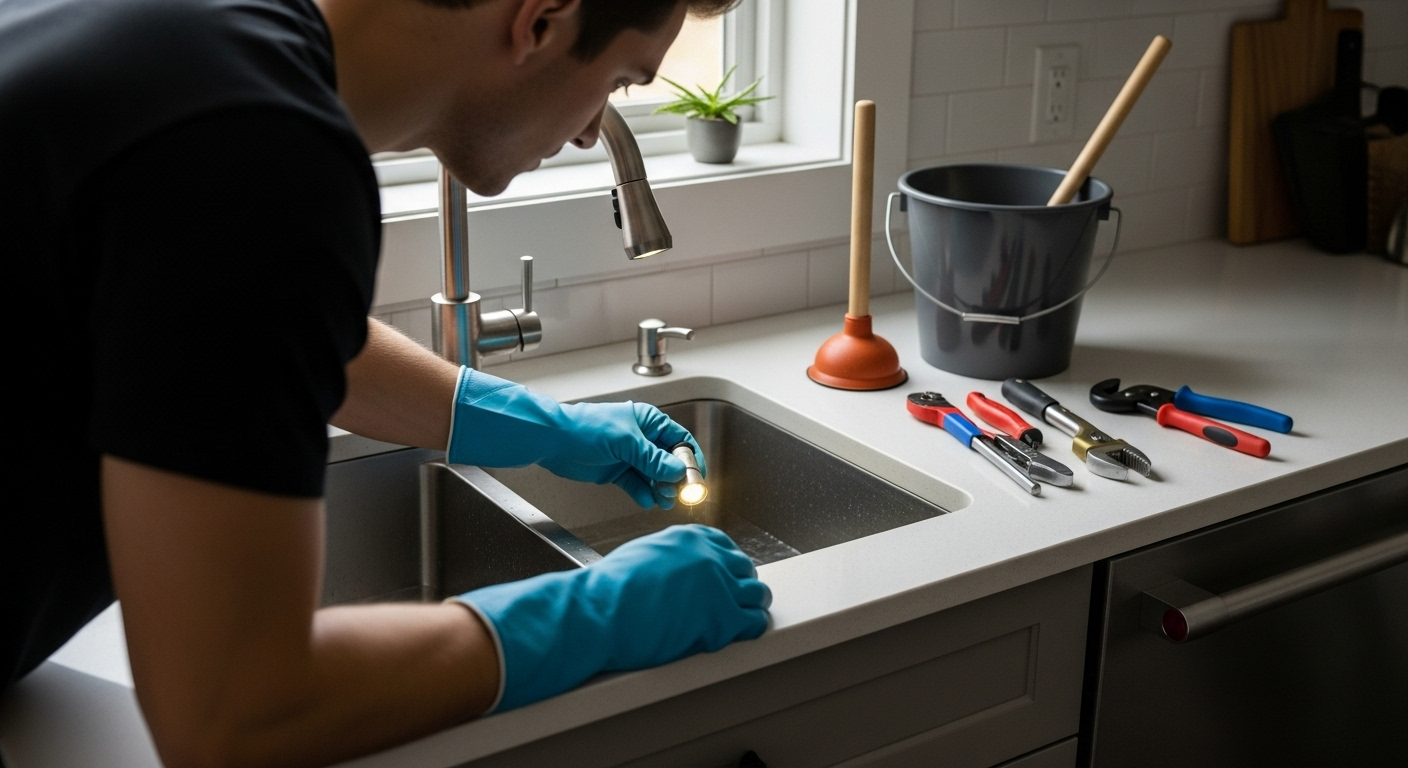Understanding Plumbing Code Basics for Homeowners in Ontario
Plumbing codes shape the safety and function of every home in Ontario. More than a quarter of residential water contamination incidents are caused by improper plumbing installations, yet these codes often get ignored by homeowners. The real surprise is that plumbing code violations can leave you without insurance and slash your home’s value, making simple compliance one of the most valuable moves you can make.
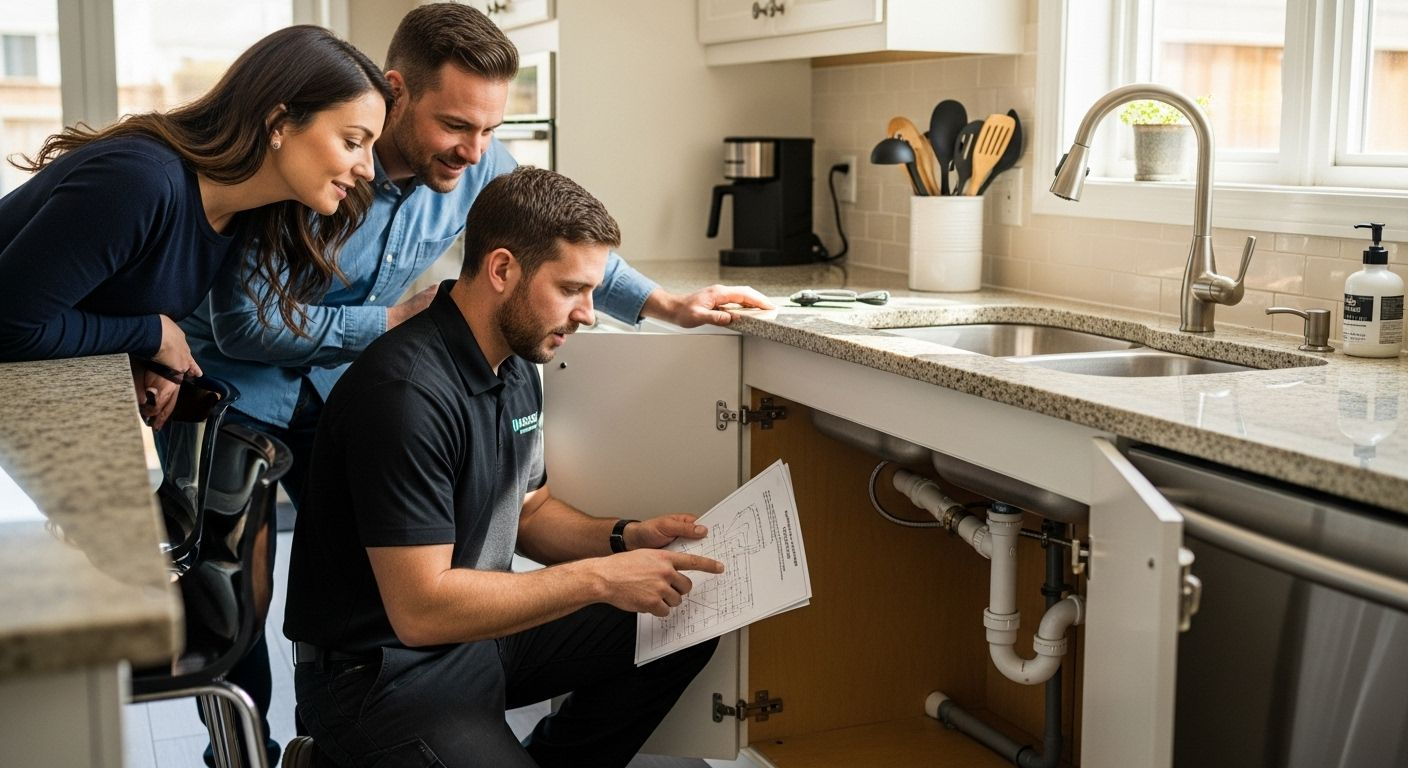
Table of Contents
Quick Summary
| Takeaway | Explanation |
|---|---|
| Understanding plumbing codes is essential. | Codes ensure safety, health, and proper system performance in plumbing installations. |
| Compliance protects against legal issues. | Following codes prevents insurance voids, liability, and costly repairs due to improper installations. |
| Proper plumbing impacts property value. | Homes with compliant plumbing systems attract buyers and maintain higher market value. |
| Municipal inspections safeguard homeowners. | Local inspections verify adherence to plumbing codes, detecting issues before they escalate. |
| Know materials and standards for safety. | Familiarity with approved materials and specifications helps ensure safe, functional plumbing systems. |
What Are Plumbing Codes and Why They Matter
Plumbing codes represent standardized regulations and technical requirements governing the design, installation, and maintenance of plumbing systems in residential and commercial buildings. These comprehensive guidelines ensure water safety, structural integrity, and public health protection across Ontario and Canada.
Understanding the Purpose of Plumbing Codes
Plumbing codes serve multiple critical functions that go beyond simple regulatory compliance. They establish fundamental standards that protect homeowners, municipalities, and entire communities from potential risks associated with improper plumbing installations.
Key purposes of plumbing codes include:
- Protecting public health by preventing contamination of drinking water
- Ensuring proper waste disposal and drainage systems
- Maintaining structural safety of buildings
- Standardizing installation practices across different regions
The Importance of Compliance for Homeowners
For Ontario homeowners, understanding plumbing codes is more than a legal requirement. It represents a proactive approach to maintaining property value, ensuring system reliability, and preventing potential expensive repairs. Plumbing codes dictate everything from pipe material specifications to appropriate fixture installations, providing a comprehensive framework for safe and efficient plumbing systems.
Municipal Enforcement and Inspections
Local municipalities in Ontario actively enforce plumbing codes through professional inspectors who verify that all plumbing work meets established provincial standards. These inspections help identify potential issues before they become significant problems, protecting homeowners from unsafe installations and potential health hazards.
Learn more about local plumbing regulations can help you better understand the specific requirements that impact your home’s plumbing system. By staying informed, you can make more educated decisions about maintenance and upgrades.
The Importance of Compliance with Plumbing Codes
Compliance with plumbing codes represents a critical responsibility for homeowners, contractors, and municipalities in Ontario. These regulations are not merely bureaucratic guidelines but essential safeguards that protect public health, ensure structural integrity, and maintain the long-term functionality of residential plumbing systems.
Legal and Safety Implications of Non-Compliance
Failing to adhere to established plumbing codes can result in significant legal and financial consequences. Improper installations may void home insurance policies, create potential liability issues, and expose homeowners to substantial repair costs and safety risks.
Key risks of non-compliance include:
- Potential invalidation of home insurance coverage
- Increased likelihood of plumbing system failures
- Health hazards from improper water and waste management
- Potential legal challenges during property sales or inspections
Financial and Property Value Considerations
Plumbing code compliance directly impacts a property’s market value and long-term maintenance expenses. Homes with properly installed and maintained plumbing systems demonstrate higher structural integrity and attract more potential buyers. Professional inspectors carefully evaluate plumbing installations during property assessments, making code compliance a critical factor in real estate transactions.
To help readers understand the multifaceted impact of plumbing code compliance, the table below summarizes key implications discussed in the article for Ontario homeowners.
| Area of Impact | Description |
|---|---|
| Legal Consequences | Non-compliance can result in denied insurance, legal challenges, and failed property sales or inspections. |
| Financial Implications | Improper installations may lead to expensive repairs, loss of property value, and higher insurance premiums. |
| Health and Safety Risks | Failing to adhere to codes increases risks of water contamination, improper waste disposal, and health hazards. |
| Structural Integrity | Compliance helps maintain building safety, system durability, and prevents premature plumbing failures. |
| Real Estate and Marketability | Code-compliant homes attract more buyers and successfully pass home inspections, ensuring higher resale value. |
Technical Standards and Professional Requirements
Professional plumbers in Ontario must maintain rigorous standards, including obtaining necessary certifications and staying updated on current plumbing code regulations. These requirements ensure that installations meet provincial safety standards and provide homeowners with reliable, efficient plumbing systems.
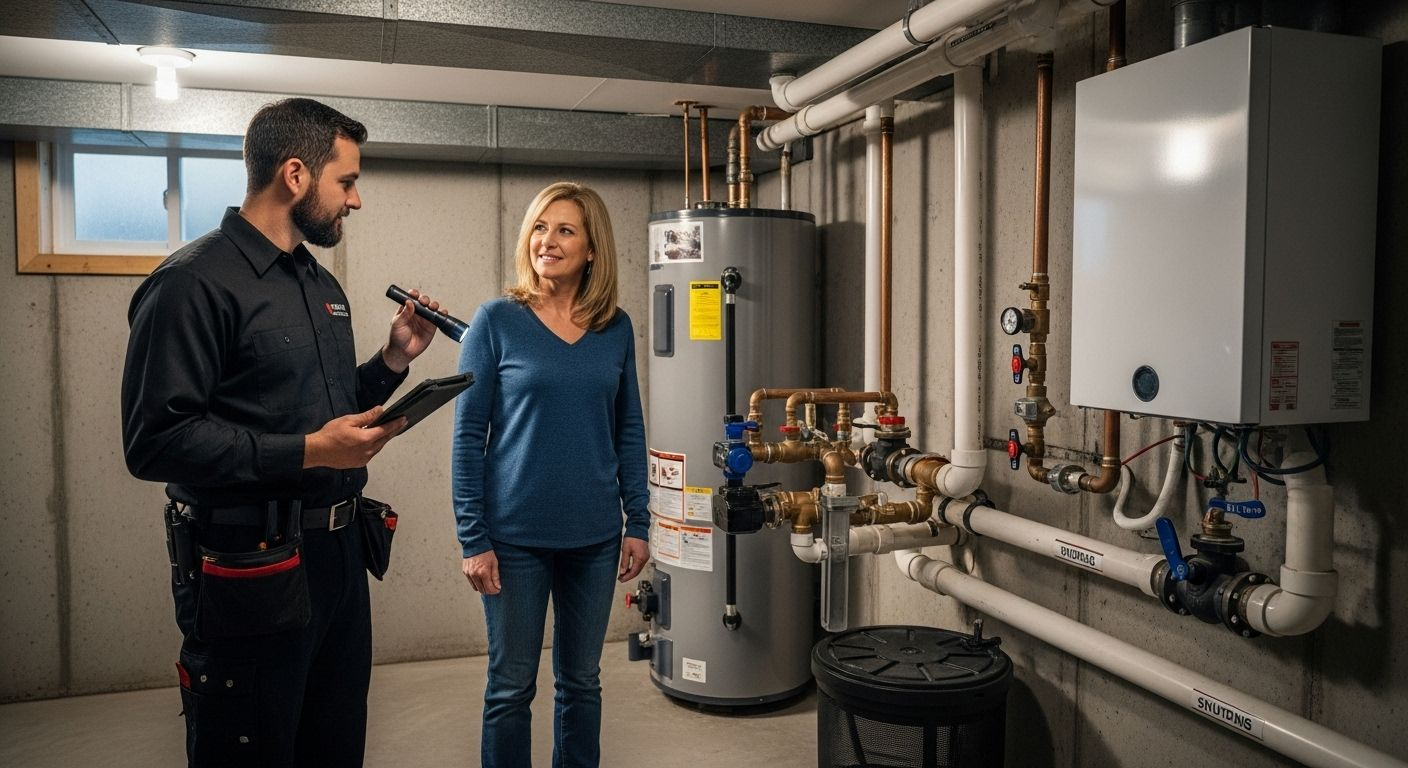
Explore our comprehensive plumbing maintenance guide to understand how proper maintenance and code compliance can protect your home’s infrastructure and prevent costly repairs.
Key Components of Plumbing Codes Explained
Plumbing codes are comprehensive technical standards that define precise requirements for designing, installing, and maintaining residential plumbing systems. These regulations encompass multiple critical components that ensure water safety, structural integrity, and overall system performance across residential and commercial buildings in Ontario.
The following table outlines core components of the plumbing codes explained in the article and summarises their main functions. This helps readers quickly grasp the technical aspects and standards that must be met in residential plumbing.
| Code Component | Main Functions and Standards |
|---|---|
| Water Supply and Distribution | Ensures use of approved materials, maintains water quality, regulates pressure, and mandates backflow prevention. |
| Drainage and Waste Management | Governs waste removal, pipe slope requirements, ventilation, and prevents environmental contamination. |
| Technical Specifications | Sets minimum performance, joining methods, pipe sizing, and fixture installation heights. |
| Material Standards | Requires compatibility and approval of materials to prevent corrosion, leaking, and health risks. |
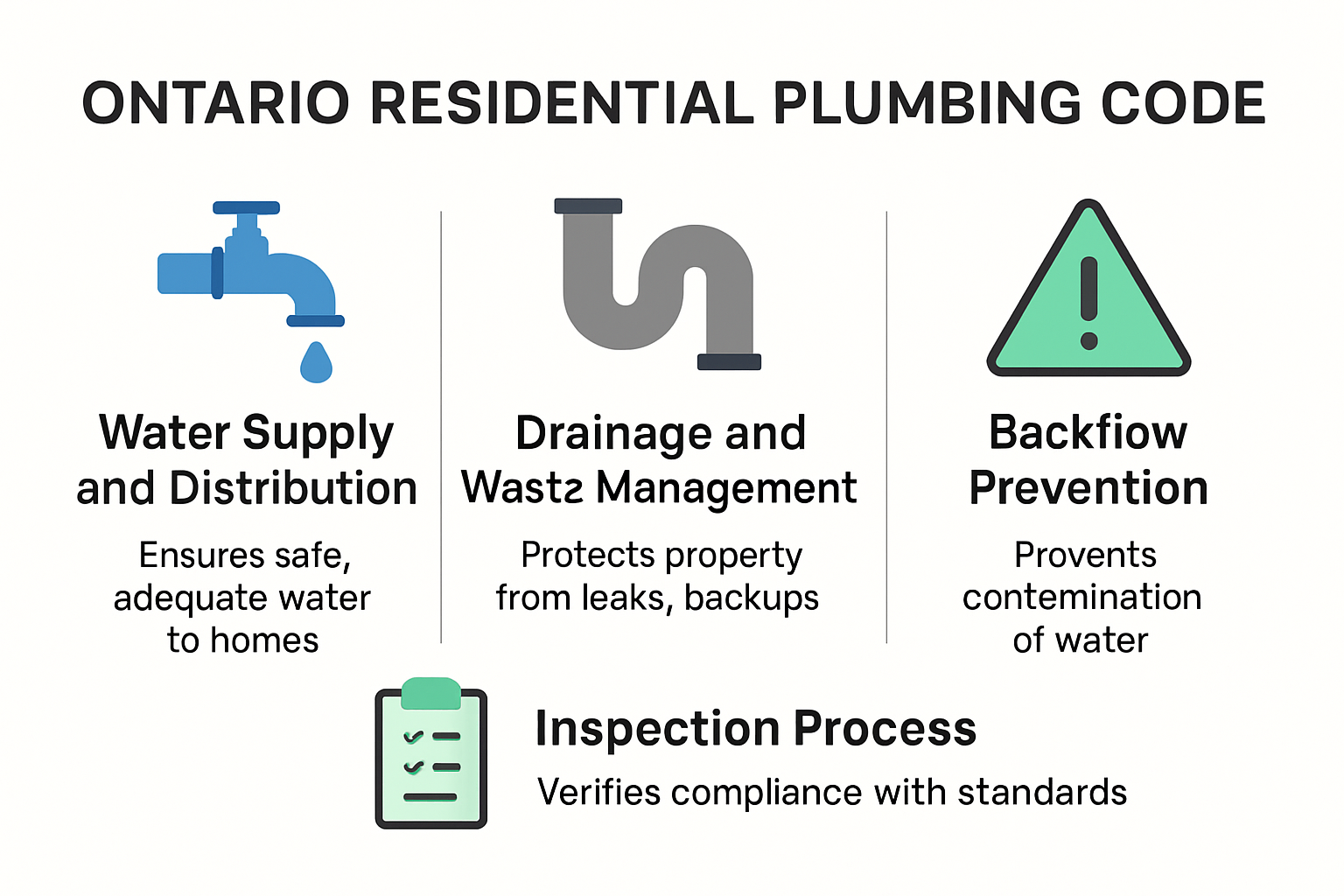
Water Supply and Distribution Standards
The water supply section of plumbing codes establishes rigorous guidelines for pipe materials, sizing, pressure requirements, and installation techniques. These standards protect drinking water quality and ensure reliable water distribution throughout residential properties.
Key water supply requirements include:
- Specifying acceptable pipe materials like copper, PEX, and CPVC
- Defining minimum pipe diameter based on fixture requirements
- Establishing pressure testing protocols
- Mandating backflow prevention mechanisms
Drainage and Waste Management Regulations
Drainage components represent another crucial aspect of plumbing codes. These regulations govern how waste water is safely transported away from residential structures, preventing potential health hazards and environmental contamination. Proper drainage design involves complex calculations related to pipe slope, ventilation, and waste flow dynamics.
Technical Specification and Material Standards
Plumbing codes provide detailed technical specifications for every aspect of plumbing system design. These specifications cover fixture installation heights, pipe joining methods, material compatibility, and minimum performance requirements for different plumbing components.
Get expert insights on plumbing system requirements to understand the intricate details that ensure your home’s plumbing meets provincial safety standards.
How Plumbing Codes Impact Home Safety and Value
Plumbing codes play a pivotal role in protecting both residential property integrity and homeowner investment. These comprehensive regulations extend far beyond simple technical requirements, serving as critical safeguards that directly influence home safety, structural performance, and long-term market value.
Health and Safety Protection Mechanisms
Plumbing codes establish multiple layers of protection designed to prevent potential health risks and structural damage. By mandating specific installation standards, material specifications, and system design requirements, these regulations create a comprehensive framework that mitigates risks associated with contamination, water-borne diseases, and structural deterioration.
Key safety protection elements include:
- Preventing cross-contamination between potable and waste water systems
- Ensuring proper ventilation to eliminate hazardous gas buildup
- Mandating backflow prevention to protect drinking water quality
- Specifying appropriate pipe materials to prevent corrosion and leaching
Property Value and Insurance Implications
Compliance with plumbing codes directly impacts a property’s market value and insurability. Professional home inspectors carefully evaluate plumbing systems during property assessments, and code violations can significantly reduce a home’s marketability. Insurance providers also consider plumbing code adherence when determining coverage eligibility and premium rates.
Long-Term Structural Integrity
Proper plumbing code implementation ensures that residential plumbing systems maintain optimal performance over extended periods. These standards account for material durability, system resilience, and potential environmental stressors, ultimately protecting homeowners from costly repairs and premature system failures.
Explore our guide on avoiding common plumbing mistakes to understand how professional standards protect your home’s infrastructure and maintain its long-term value.
Real-World Examples of Plumbing Code Applications
Plumbing codes translate complex technical requirements into practical guidelines that directly impact residential infrastructure. These regulations provide concrete solutions to potential plumbing challenges, ensuring safe and efficient water systems across Ontario homes.
Practical Residential Installation Scenarios
Real-world plumbing code applications demonstrate how theoretical standards protect homeowners from potential infrastructure failures. For instance, specific regulations govern critical aspects of water system design, such as pipe installation, fixture connections, and drainage configurations.
Typical residential code application scenarios include:
- Specifying minimum distances between water supply lines and potential contamination sources
- Defining precise slope requirements for drainage pipes to prevent waste accumulation
- Establishing clear guidelines for water heater placement and ventilation
- Mandating specific pipe joining techniques to prevent future leaks
Water Safety and Cross-Contamination Prevention
Plumbing codes provide explicit instructions for preventing water contamination. These regulations require specific installation techniques and materials that create physical barriers between potable water systems and potential contamination sources. Professional plumbers must follow intricate guidelines that protect residential water quality and prevent potential health risks.
Structural Integrity and System Performance
Code applications extend beyond immediate safety concerns, addressing long-term system performance and structural considerations. Regulations dictate pipe material selection, connection methods, and system design principles that ensure residential plumbing systems can withstand environmental stress and maintain optimal functionality.
Discover professional insights on plumbing system requirements to understand how expert implementation of plumbing codes protects your home’s infrastructure.
Get Peace of Mind With Code-Compliant Plumbing in Ontario
Worried about whether your home’s plumbing meets Ontario’s strict codes? Many homeowners feel anxious about hidden dangers like leaks, faulty pipes or improper installations that can impact insurance and property value. At DrainWorks Plumbing, we specialize in code-compliant residential plumbing that keeps your family safe, safeguards your investment and helps you avoid costly surprises. We understand the language of plumbing codes and the real-world protection they offer your home.

Let our fully licensed and insured team handle your plumbing challenges the right way from repairs to major upgrades so you never need to second guess your system’s integrity. We have more than 30 years of trusted experience with Toronto homes. Visit DrainWorks Plumbing to book a same-day appointment or learn what makes our technicians different. If you want the assurance of work that meets Ontario’s highest standards, see how we can help you stay compliant today. Don’t risk your home’s safety—get expert help now.
Frequently Asked Questions
What are plumbing codes?
Plumbing codes are standardized regulations that govern the design, installation, and maintenance of plumbing systems in residential and commercial buildings. They ensure water safety, structural integrity, and public health protection.
Why is compliance with plumbing codes important for homeowners in Ontario?
Compliance with plumbing codes is crucial for homeowners as it protects public health, ensures safe waste management, preserves property value, and prevents costly repairs that may arise from improper plumbing installations.
What are the risks of not adhering to plumbing codes?
Failing to adhere to plumbing codes can lead to legal and financial consequences, including voided home insurance, increased likelihood of plumbing system failures, health hazards from improper waste management, and potential legal challenges during property sales or inspections.
How do plumbing codes affect home insurance?
Plumbing code compliance is a significant factor in determining home insurance premiums and coverage eligibility. Insurance providers may deny claims related to plumbing issues if the work does not meet established codes, highlighting the importance of adhering to these regulations.
Recommended
[PLUMBERS IN TORONTO: HOW TO CHOOSE THE RIGHT COMPANY]( https://drainworks.com/plumbing-blog/plumbers-in-toronto-how-to-choose-the-right-company )
[Planning a Reno? Why You Should Start With Your Plumbing.]( https://drainworks.com/plumbing-blog/planning-a-reno-why-you-should-start-with-your-plumbing )
[Plumbing FAQ’s | Frequently Asked Plumbing Questions]( https://drainworks.com/plumbing-faqs )
[Plumbing ‘DIY’ Projects to Avoid | DrainWorks Plumbing Toronto]( https://drainworks.com/plumbing-blog/plumbing-diy-projects-to-avoid )




